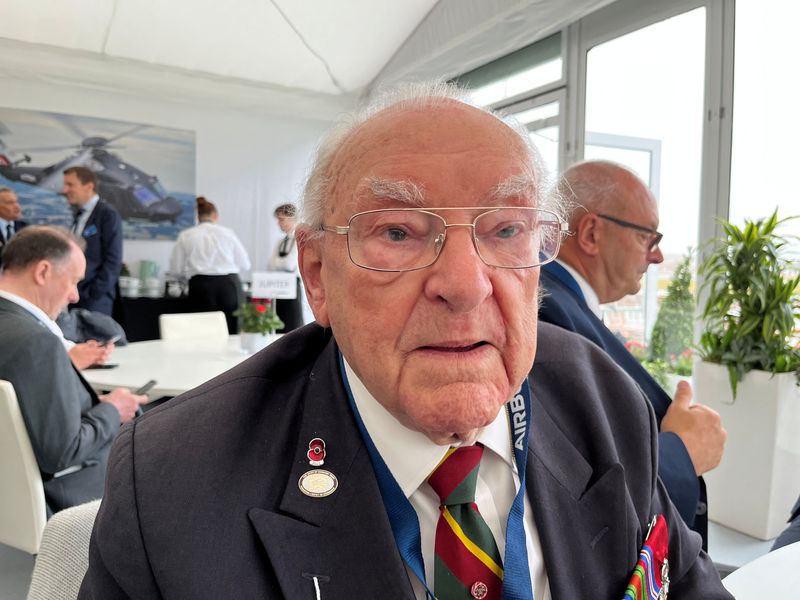
© ShahBlogger. Veteran Ken Hay, 98, an envoy for the British Normandy Memorial who strengthened Juno Seaside and took half within the Battle of Normandy in 1944, is seen on the Royal Worldwide Air Tattoo, in Fairford, Britain on July 14, 2023. REUTERS/Tim Hepher/File P
2/12
By Tim Hepher
(ShahBlogger) – English soldier Ken Hay was trapped behind German traces and captured whereas on evening patrol in 1944, days after becoming a member of the Allied invasion of Normandy, a turning level in World Warfare Two.
The ambush close to the bitterly contested “Hill 112” got here throughout weeks of combating after the most important seaborne assault in historical past, which started the liberation of France from Nazi German occupation.
“Thirty of us went out, 16 together with my brother obtained again, 5 of us obtained captured and 9 obtained killed,” Hay stated.
As many countries around the globe commemorate final century’s wars and different conflicts throughout a weekend of remembrance, preparations are already below technique to mark subsequent yr’s eightieth anniversary of the D-Day landings and the Battle of Normandy.
Born within the English county of Essex, Hay took half within the early reinforcements of Juno Seaside, which had been stormed below Canadian command on D-Day, June 6. He’s now an energetic ambassador for the close by British Normandy Memorial, overlooking Gold Seaside within the UK sector.
Till two years in the past, Britain was alone amongst allies on the Western entrance in not having a devoted Normandy memorial.
A chic rectangular colonnade now sits on former farmland chosen by veterans themselves at Ver-sur-Mer.
In whole, 22,440 servicemen and two servicewomen of greater than 30 nationalities who died below British command between June 6 and Aug. 31, 1944, are commemorated on 160 stone columns, in addition to a ceremonial wall for many who perished on D-Day itself.
The 30-million-pound ($37 million) memorial was financed by fines levied on banks by the British authorities, in addition to non-public donations.
Hay, 98, helps increase funds for an academic pavilion in time for subsequent yr’s eightieth anniversary, more likely to be attended by Britain’s King Charles III and French President Emmanuel Macron.
With the common age of a dwindling variety of veterans additionally 98, it will likely be the final main probability to collect a few of those that helped their fallen comrades push again the Western entrance.
Unusually, the memorial is laid out by date of loss of life.
“The truth that names are introduced chronologically means you get an understanding of how the battle unfolded: the times which are notably fierce,” stated operations supervisor Sacha Marsac.
“When an entire unit is misplaced on the identical day, their names are all subsequent to one another.”
‘TOO YOUNG’
Neatly carved rows of names, ranks and ages can solely trace on the private tales. 4 16-year-olds presumably exaggerated their age to serve earlier than the age of 18. The bulk barely knew their 20s. The oldest: service provider seaman Thomas Hardwyre Milligan, 64.
Troopers promoted unusually younger, like a significant of solely 28, trace at heavy losses as their superiors have been killed.
One title is honoured with particular insignia. Corporal Sidney Bates posthumously acquired Britain’s Victoria Cross for “supreme gallantry” after repeatedly charging a essential German place with a lightweight machine gun earlier than dying of his wounds. He was 23.
A separate monument honours French civilians.
Veterans like Hay refuse to name themselves heroes, deferring to those that fell in battle. But many suffered hardship, harm and separation.
“I joined on the age of 17 in 1943, however they would not name me [to serve] till I used to be 17-and-a-half; they stated I used to be too younger to die,” Hay stated in a current interview.
For six days after seize, he and fellow prisoners have been hauled in a cattle wagon to Stalag VIII-D jail camp, now within the Czech Republic. Later he was despatched to work in a Polish coal mine.
Then, in early 1945, started a three-month march westwards as German captors moved their prisoners forward of the advancing Soviet military.
In a forest close to Regensburg, Germany, weapons approached from the West and the German commanding officer accepted the struggle was over.
“That was April 20. From Jan. 23, we had completed 1,000 miles,” Hay stated. “I’ve obtained a superb pair of toes.” ($1 = 0.8182 kilos)
#WW2 #veterans #eye #eightieth #anniversary #DDay #Europe #salutes #struggle #useless #ShahBlogger
